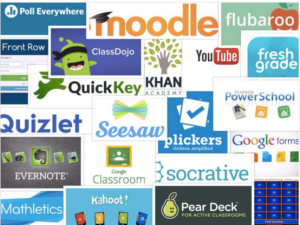Over the course of the semester we have taken a look at the history of educational technology through theories, how they have changed and reshaped education as we move forward. Obviously some of the biggest changes to learning in course of history were the printing press, then the incorporation of radio, tv, and now we are looking at multimedia and the vast amount of ed tech options.
The thing I appreciated the most from this class was how I was able to look at my teaching, what I am using within my classroom, how am I interacting with students, engaging students, developing a deeper understanding of curriculum through using or sometimes making the conscious choice not to use “ed tech”. Compounding the theories behind the different tools we use as educators and gaining a deeper understanding for why I am using these tools has opened my eyes and changed my reasoning for my pedagogical stance on using ed tech within the classroom.
I think one of the most influential quotes that I remembered came from an early reading of Postman’s article on the 5 things we need to know about tech change.
I feel that this quote defines my summary of this course. Aside from the religious connotation to it I found that this has so many truths.
After a riveting lesson on our favorite theorists, we began the semester by looking at educational television. This made me look at why I am using videos within my classroom. Prior to this class I felt that it helped develop a blended learning environment that enabled my students to review, relearn, or go beyond the classroom teaching and inquire themselves into a topic. After this class I realize that using videos plays an important role in the students learning, but only if it is engaging. This is the part that I needed to learn. Using the videos, or tv shows to enhance the learning is only one way, and that simply viewing only allows the students to learn at a low level because it is only reinforcing behaviourist expectations. Showing the “engaging” video requires the students to sit, watch and listen. If I am not extending this opportunity with meaningful constructivist or connectivist pre or post teaching concepts I am not teaching to the whole child like I should be.
This realization led into the next two weeks where we discussed media and ed tech advancements. This is where I was able to take a closer look at the tools I am using within my classroom. Specifically my Google Apps For Education centred classroom. Critically looking at how I am using media, videos and the GAFE apps within my classroom gave me the opportunity to understand why I use the tools the way I am using them. I feel that through this critical lens I broke down my teaching and realized that I need to be improving my techniques so the students are getting more constructive and connective opportunities. Through developing these opportunities it will allow more autonomy for my students to learn on their own while using the technology tools. Specifically I reflected on how I use my Google docs and the range of uses I have for them. Whether they are used as a substitute for their pen and paper note book when answering short answer questions from a short story, to collaborating as a small group to develop a presentation, or into an ongoing independent research project where each student demonstrates their knowledge of a topic. I found this gave me the chance to redesign some of the recurring projects we do at my school so they can be more influential for the students learning the next time we cover the topic.
The autonomy piece began to frighten me as we discussed the development of the Web from 1.0 to 2.0 to the future of what 3.0 may look like. Setting the rules and procedures for what is expected, allowed, and developing a positive digital citizens is very important but on top of my actual curriculum that is mandated by the province I feel like
When I look at the final weeks I think about the fun ways to evaluate and assess students. There are so many different ways to fomatively or summatively assess, but I have to say, the one my students love the most is through kahoot! The level of participation I have in these classes is amazing. I can not say enough positives about this tool. I do like plickers and we have to use pearson through our board, but when you can have students excited about a quiz, that's amazing!
When we looked at Assistive tech, I look to a definition within the reading “rethinking assistive tech” by Dave Edyburn.
Now Mr. Edyburn went on to dismantle and edit that
definition. Probably the largest piece
for me would be the concept of AT being able to improve the function for anyone
in need.
In my classroom, I am focusing on how to incorporate and utilize
GAFE Google Read Write. It has a variety
of functions that I am only beginning to become familiar with. This tool is
very versatile and has the capability to help any person. I have shared the basics of the Read Write
program with the majority of my 7/8s in my school and I see a large portion of
them using it to some capacity on an ongoing basis. This is what makes this tool so awesome. It is functional for everyone to use and
therefore it has become a normal practice within our pod, so that the ones who “need”
it as an assistive tool to improve their successes do not feel out of place
when capitalizing on this opportunity.
Finally I would like to thank everyone in this semesters ECI
833 class and to our leader Alec for running another great ed tech class.








